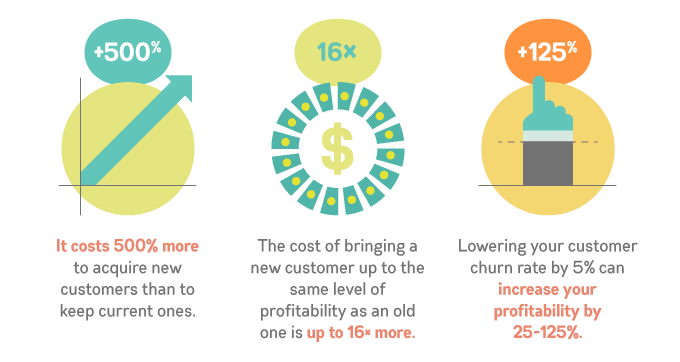Misc
Here’s 5 Ways to Build Customer Loyalty, According to Science
Regardless of whether you are an entrepreneur, investor, or a business professional, the concept of customer loyalty is a crucial one.
The fact is that 68% of customers leave because they feel brands do not care about them, and the cost of these lost customers can add up fast. It’s estimated that acquiring new customers is 500% more expensive than keeping old ones.
How can brands get customers to keep coming back, to avoid the problem of high churn?
The Science Behind Customer Loyalty
One way of looking at customer loyalty is to think about the underlying behavioral psychology.
Today’s infographic is from West, and it outlines some of psychological principles surrounding customer loyalty, and how they can be applied to help retain existing customers.

Retaining customers is vital to success, but achieving a low churn rate is never an easy task. After all, customers can be fickle, and brands already invest millions each year to make sure they can handle extremely high volumes of customer interactions.
How can brands lower their churn, while making the most out of their customer interactions?
Five Ways to Build Customer Loyalty
Here are some tried and true methods that help build customer loyalty, and why:
1. Deliver unexpected rewards
Unexpected rewards produce a huge rush of dopamine to the brain. By rewarding customers when they least expect it, brands can really make an impression.
2. Start and end strong
People tend to have cognitive biases towards the first and last things they experience. By making sure the customer experience is strong at both of these touch points, odds can be improved that they will come back.
3. Create a social identity
Social identity theory shows that when people feel a part of an established in-group, they are more likely to stay loyal to that group. Brands can help by creating or nurturing these channels, allowing customers to develop bonds with each other, as well as the company.
4. Let customers share rewards
People are frequently motivated by helping others, so giving customers the opportunity to share benefits or rewards can create a new facet to the customer relationship.
5. Show customers you share their values
Studies show that customers rate shared values as a key reason behind their relationships with brands. Make sure you communicate brand values loud and clear.
United States
Charted: What Southeast Asia Thinks About China & the U.S.
A significant share of respondents from an ASEAN-focused survey are not happy about rising American and Chinese influence in the region.

What Southeast Asia Thinks About China & the U.S.
This was originally posted on our Voronoi app. Download the app for free on iOS or Android and discover incredible data-driven charts from a variety of trusted sources.
This chart visualizes the results of a 2024 survey conducted by the ASEAN Studies Centre at the ISEAS-Yusof Ishak Institute. Nearly 2,000 respondents were asked if they were worried or welcoming of rising Chinese and American geopolitical influence in their country.
The countries surveyed all belong to the Association of Southeast Asian Nations (ASEAN), a political and economic union of 10 states in Southeast Asia.
Feelings Towards China
On average, a significant share of respondents from all 10 countries are worried about rising influence from both the U.S. and China.
However, overall skepticism is higher for China, at 74% (versus 59% for U.S.).
| Country | Worried About Growing 🇨🇳 Influence | Welcome Growing 🇨🇳 Influence |
|---|---|---|
| 🇧🇳 Brunei | 58% | 42% |
| 🇰🇭 Cambodia | 66% | 34% |
| 🇮🇩 Indonesia | 57% | 43% |
| 🇱🇦 Laos | 68% | 32% |
| 🇲🇾 Malaysia | 56% | 44% |
| 🇲🇲 Myanmar | 95% | 5% |
| 🇵🇭 Philippines | 81% | 19% |
| 🇸🇬 Singapore | 74% | 26% |
| 🇹🇭 Thailand | 84% | 16% |
| 🇻🇳 Vietnam | 96% | 4% |
| Average | 74% | 27% |
The recently-cooled but still active territorial concerns over the South China Sea may play a significant role in these responses, especially in countries which are also claimants over the sea.
For example, in Vietnam over 95% of respondents said they were worried about China’s growing influence.
Feelings Towards America
Conversely, rising American influence is welcomed in two countries with competing claims in the South China Sea, the Philippines (69%) and Vietnam (55%).
| Country | Worried About Growing 🇺🇸 Influence | Welcome Growing 🇺🇸 Influence |
|---|---|---|
| 🇧🇳 Brunei | 73% | 27% |
| 🇰🇭 Cambodia | 58% | 42% |
| 🇮🇩 Indonesia | 73% | 27% |
| 🇱🇦 Laos | 79% | 21% |
| 🇲🇾 Malaysia | 68% | 32% |
| 🇲🇲 Myanmar | 45% | 55% |
| 🇵🇭 Philippines | 32% | 69% |
| 🇸🇬 Singapore | 37% | 63% |
| 🇹🇭 Thailand | 80% | 20% |
| 🇻🇳 Vietnam | 45% | 55% |
| Average | 59% | 41% |
Despite this, on a regional average, more respondents worry about growing American influence (59%) than they welcome it (41%).
Interestingly, it seems almost every ASEAN nation has a clear preference for one superpower over the other.
The only exception is Thailand, where those surveyed were not a fan of either option, with 84% worried about China, and 80% worried about the U.S.
-

 Best of6 days ago
Best of6 days agoBest Visualizations of April on the Voronoi App
-

 Brands2 weeks ago
Brands2 weeks agoHow Tech Logos Have Evolved Over Time
-

 Energy2 weeks ago
Energy2 weeks agoRanked: The Top 10 EV Battery Manufacturers in 2023
-

 Demographics2 weeks ago
Demographics2 weeks agoCountries With the Largest Happiness Gains Since 2010
-

 VC+2 weeks ago
VC+2 weeks agoVC+: Get Our Key Takeaways From the IMF’s World Economic Outlook
-

 Demographics2 weeks ago
Demographics2 weeks agoThe Countries That Have Become Sadder Since 2010
-

 Money2 weeks ago
Money2 weeks agoCharted: Who Has Savings in This Economy?
-

 Technology1 week ago
Technology1 week agoVisualizing AI Patents by Country














